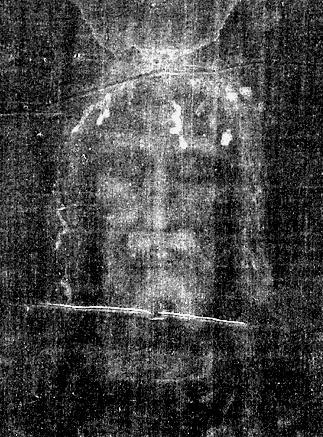I have read Fr. Carmine Cucinelli rebuttal. It is not a rebuttal from a scientific or scholarly position... it is more what Fr. Carmine believes, rather than established facts.
"...As Sr. Blandina Pascalis Schlomer has shown that the Holy Face is able to be perfectly superimposed over the Shroud of Turin, the presumed painter, let’s say Albert Durrer, would first have had to place his cloth over the Shroud and copy onto it exactly the characteristics of the negative. ..."
Sorry, but Sr. Bandina's "scientific" approach was to place a photograph of the Manoppello image over a photograph of the Shroud... and then claim that it was an exact match. It isn't. Her further method was to hold a transparent plastic ruler up to the Manoppello image and then measure on the Shroud photograph... which was not guaranteed printed to scale. First direct measurements of both cloths show that the head sizes are completely different. Second, the Shroud image has a pronounced mustache and beard while the Manoppello image does not... The mustache and beard of the Manoppello image are best described as "wispy." Secondly, other scientists, more skilled in comparative projection, have found that the two images are similar only in that both are human male faces... and bear the same similarity to any such faces.
Iconographic analysis of the Manoppello Veil finds that there are numerous points of congruity and similarity with the known self-portraits of Raphael, much more than with the face on the Shroud of Turin. While none of the exemplar self portraits are guaranteed to be "life size" neither can we assume that the Veil is "life size," but the positioning, eyebrow , eye shape, lips, expression, and beard styles do provide an amazing number of point of consistency with Raphael and not the man on the Shroud.
Look at them side by side:


I agree that the image does not match the contemporary images of Albrecht Durer, however, it is an almost exact match for Raphael's contemporary self portraits. There are extant contemporary documents that establish that Raphael, fascinated by Durer's technique, duplicated it and sent a self portrait to Durer. Compare the Manoppello image to a later (than the Durer-Raphael self-portrait exchange) Raphael self-portrait:


The similarities are far stronger between the image and Raphael than between the Image and the Shroud above.
As to the impossibility of painting on Byssus (If it is Byssus it might be Cambric, a very fine cotton), nothing could be farther from the truth. In fact, photomicrographs of the Manoppello image HAVE been made through the glass and paint particles are seen clinging to the fibers particularly in the area of the whites of the eyes and the teeth seen inside the mouth. Father Carmine argues that paint will not stick to Byssus... but that it can be stained. However, he shoots himself in the foot when he writes: "If one might find something one could only speak of a strip of paint applied afterwards to highlight some pre-existing detail of the image." If that "strip of paint" is there (and there are many), then how does IT adhere to the byssus if, as he claims, paint will not stick?
The Father's argument that color changes such as he claims to see in the Manoppello image only occur in nature is also false. I suggest you look at any number of man-made objects with iridescence... including a modern $20 bill, many vases made by Tiffany, and any number of very fine cloths. As a matter of fact, the iridescence is inherent in the Byssus which is one of the qualities that makes it, by far, the most expense cloth in the world. Finely woven Cambric can also display iridescence.
Finally, contrary to the good father's assertion that the artist had to have had access to the Shroud to copy it, he is again wrong. That assertion is based on the assumption that the face IS a rendition of the face of Jesus and IS a copy of the face on the Shroud. That's begging the question.
Father Carmine is not a scientist... he is a believer. Father Carmine's arguments are pious dogma... he sees what he wants to believe, not what is actually there.
